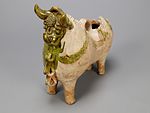Vessel
About this object
History of use
Starting in colonial times, the finest young bull was chosen and ritually cut and white washed at the annual marking of the herd. The cuts were treated to stop bleeding, then the bull was decorated with flowers and fruit. Finally, coca leaves were burned and a fiesta followed. Cattle are no longer raised in pucara area, but the bull, with its symbolic cuts in the shape of a saddle and harness and bedecked with flowers survives in the ceramic version.
Narrative
Contemporary
Iconographic meaning
The pottery bull commemorates the traditional cattle-marking ceremony of Pucara area. The ceremony gave thanks for the fertility of the herd. Today, similar ceremonies take place throughout Peru on April 25, the feast day of San Marcos.
Physical description
A fully modelled ceramic bull of light orange clay, crudely painted white with details in brown paint and green slip. Details of harness and saddle are flat while flowers, tail, tongue etc., are modelled additions. The bull is hollow with a small strap handle in front of the vessel mouth on the animal's back. The loops of fat at the front of the neck, which are part of the ritual cutting and featured prominently.
